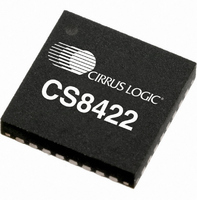CS8422-CNZ Cirrus Logic Inc, CS8422-CNZ Datasheet - Page 30

CS8422-CNZ
Manufacturer Part Number
CS8422-CNZ
Description
IC SAMPLE RATE CONVERTER 32QFN
Manufacturer
Cirrus Logic Inc
Type
Sample Rate Converterr
Datasheet
1.CS8422-CNZ.pdf
(82 pages)
Specifications of CS8422-CNZ
Package / Case
32-QFN
Applications
Digital Audio
Mounting Type
Surface Mount
Maximum Operating Temperature
+ 125 C
Minimum Operating Temperature
- 55 C
Mounting Style
SMD/SMT
Package
32QFN
Operating Temperature
-55 to 125 °C
Audio Control Type
Sample Rate Converter
Control Interface
I2C, SPI
Supply Voltage Range
1.71V To 5.25V
Operating Temperature Range
-40°C To +85°C
Audio Ic Case Style
QFN
No. Of Pins
32
Rohs Compliant
Yes
Lead Free Status / RoHS Status
Lead free / RoHS Compliant
For Use With
598-1568 - BOARD EVAL FOR CS8422 RCVR
Lead Free Status / Rohs Status
Lead free / RoHS Compliant
Other names
598-1732
Available stocks
Company
Part Number
Manufacturer
Quantity
Price
Company:
Part Number:
CS8422-CNZ
Manufacturer:
CIRRUS
Quantity:
99
Part Number:
CS8422-CNZ
Manufacturer:
CIRRUS
Quantity:
20 000
Part Number:
CS8422-CNZR
Manufacturer:
CIRRUS
Quantity:
20 000
30
Receiver Input Mode 1 (Analog Sensitivity Mode)
Receiver Input Mode 2 (Digital Sensitivity Mode)
6.2.2.1
When the receiver input multiplexer is set to Single-Ended Mode, the receiver inputs can be switched be-
tween operation as comparator inputs or digital inputs.
If Mode 1 is selected, the inputs are biased at VA/2 and should be coupled through a capacitor. The rec-
ommended value for the AC coupling capacitors is 0.01 µF to 0.1 µF. The recommended dielectrics for
the AC coupling capacitors are C0G or X7R.
When the receiver input multiplexer is in Mode 1, the receiver input pins allow very low amplitude signals
to be decoded reliably. In this mode, the maximum allowable input amplitude is determined by VA, which
is nominally 3.3 volts. If input amplitudes greater than 3.3 Volts to a single pin of the receiver input multi-
plexer are required, then attenuation is necessary prior to the receiver input to avoid damage to the part
(See
receiver in Single-Ended Mode.
If Mode 2 is selected, the receiver inputs should be driven by a digital signal referenced to VA. In this
mode, the selected receiver input is not biased, and does not require the use of an AC coupling capacitor
(as with the use of a typical optical receiver output).
When the receiver input multiplexer is in Mode 2 the specifications for V
ifications” on page 17
6.2.2.2
When the receiver input multiplexer is set to differential input mode, the inputs are biased at VA/2, and
require the use of AC coupling capacitors, as mentioned in
of the receiver in differential mode.
Note:
1. If RX[3:0] is selected by either the receiver MUX or the TX pass-through MUX, N=1.
2. If RX[3:0] is selected by both the receiver MUX and the TX pass-through MUX, N=2.
3. If RX[3:0] is not selected at all, N=0 (i.e. high impedance).
RX[3:0]
“Attenuating Input signals” on page 65
Figure 17. Single-Ended Receiver Input Structure, Receiver Mode 1
Single-Ended Input Mode
Differential Input Mode
(1500 + 1500/N)
for more details).
for more details).
22 k
22 k
AGND
Section
VA
Figure 17
6.2.2.1.
(22000/N)
(22000/N)
+
-
IH
/V
shows the input structure of the
IL
Figure 18
apply (see
shows the structure
“Switching Spec-
CS8422
DS692F1

















